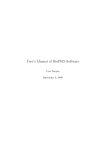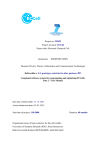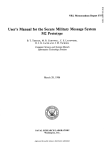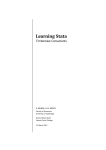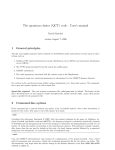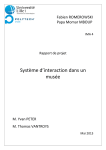Download Declaration of the external interface between the ng_biopro
Transcript
Declaration of the external interface between
the ng_biopro-software and another external
control-program
Uwe Tangen
Version 0.51, 05 September 2008
Uwe Tangen Ruhr-University-Bochum
Abstract
The aim of this specication is to allow external programs to control
essential parts of the Omega-machine via an as simple as possible interface.
The general idea behind this is to plug the ng_biopro-software into an
externally provided optimization and control-system to facilitate a systemintegration on a larger scale.
The interface will not encompass all ng_biopro-software functionalities
but expects the experimenter to setup the experiment with the ng_bioprosoftware and after having done so giving control to the external program.
1 General setup
The ng_biopro-software partially works as a client of the Bio@Fox-board, provides the interface to the camera and will retain full control of the Omegamachine. The software will open an external TCP-socket at port 8086 to allow
for external control when it is launched with the option '-ext'.
Before it makes sense to control parts of the Omega-machine with the external program the experiment has to be set up already. Everything should be
as prepared as a normal experimental session would require.
The external program is launched and it opens the port 8086 at the ng_bioprosoftware (the IP-address must be the address of the machine running the ng_bioprosoftware).
Example:
ssh liszt -l biopro
cd test
ng_biopro_i686 -ext -srv
1
The server-option is useful if the ng_biopro-software should be used
for testing-purposes.
If a rewall is between the machine execut-
ing the external program and the machine executing the ng_bioprosoftware, the port 8086 must be tunneled through the SSL-connection,
which currently is not working - sorry.
ssh liszt -l biopro -L 8086:liszt:8086
and start the external program with
ng_biopro_external localhost 8086
The external control-program acts as a client to the ng_biopro-software. The
external program opens a control-session with specifying a certain name for
that session and perhaps additional data in a comment-string. The name of the
control-session is always printed out when actions are logged. When nishing the
control session, the external-program shall close the session with an appropriate
command to allow for a graceful shutdown of the TCP-connection.
The general communication between the external client and the ng_bioprosoftware is realized via the exchange of ASCII-strings.
Binary data is NOT
communicated. This saves from the problem of little and big-endian machines.
A communication string starts with the length of the string, given in bytes,
and a 1 byte command.
Atom-delimiter is the space (blank, 0x20).
begin with a non-'0' character and hex-numbers with '0x'.
contain at least a '.'
or an 'e' in the set of digits.
Integers
Doubles or oats
Upper and lower case
DOES matter, 'a' is NOT equal 'A'. Strings with blanks are encapsulated with
quotation-marks (0x22).
Sometimes commands require acknowledgements. The simple acknowledgement is given by a
y (0x79) and the appended session-name, which allows the
external program to check the communication channel.
If there are sequences of items, be it atomic-names, numbers or strings, these
sequences are prepended with the number of these items. E.g., naming three
colors as a list would be written as: 3 black white yellow.
2 The commands specication
In the examples shown below the length of the commands will not be shown.
It is determined via the strlen()-function in a lower level of the communication
system.
2.1
Quick-list of all commands and return-parameters
2.1.1 Commands which can be sent to the ng_biopro-software
(Caution: all hardware related names are specic to the BioMIP-setup. They
might be dierent in test- or other lab-environments!)
a
' ' (0x61) - Set AOTF or light-source intensity (2.4.3) {name [biofox_blue,
biofox_red, biofox_yellow]} [{intensity [0..63]}]
2
'B' (0x42) - Start (begin) a predened cylce (2.3.1) {qualier [aotf, camera, lter, level_one, light, macro, measurement, pin, prepos,
pump, sensor, sequence, series, temp_cycle, wheel, xyzpos]}
{name} [{start at position n (from zero counted)}] /* not yet implemented
*/
C' (0x43) - Dene camera parameters (2.4.1) {name [eval_cam]} [{expo-
'
sure time in seconds} [{camera gain [0..255]}]].
c
' ' (0x63) - Close a session (2.2.1)
' ' (0x64) - List all pins available in design (2.2.2)
'E' (0x45) - Stop (end) a predened running cycle (2.3.2) {qualier [aotf,
camera, lter, level_one, light, macro, measurement, pin, prepos, pump, sensor, sequence, series, temp_cycle, wheel, xyzpos]} {name} [end] /* not yet implemented */
'e'
d
(0x65) - Apply a certain potential to an electrode (2.3.5) {pin-ID
[0x80008f0]} {polarity [-, +, z]}
'f' (0x66) - Set a lter-wheel to a specied position (2.3.6) {wheel-name
[emission]} {lter-position [1..10]}
'G' (0x47) - Get status of a predened cycle (2.3.3) {qualier [aotf, camera, lter, level_one, light, macro, measurement, pin, prepos,
pump, sensor, sequence, series, temp_cycle, wheel, xyzpos]}
{name} /* not yet implemented */
'g' (0x67) - Get a value of a sensor (2.3.7) {nr.
of sensors [1..n]} {sensor-
IDs [0x20008f4, ..]}
'i' (0x69) - Get an image from server (2.3.8)
I
' ' (0x49) - Get status from calling a shell-script (2.2.3) {parameters for
shell-script}
l
' ' (0x6c) - List a sensors-data (2.2.5) {sensor-ID [0x2000013]}
'
'
' ' (0x6e) - Set norm-duty, active-duty and reference-cycle (2.4.4) {type
L' (0x4c) - Extract a list of names (2.2.4) {qualier [aotf, camera, lter, level_one, light, macro, measurement, pin, prepos, pump,
sensor, sequence, series, temp_cycle, wheel, xyzpos]}
m' (0x6d) - List all measurement bodies (2.2.6)
n
norm, active, ref ]} [{value [0..]}]
[
o
' ' (0x6f ) - Open a session (2.2.7) {session name} [{comment}]
' ' (0x70) - Dene new pump-parameters (2.4.5) {pump-ID [1..]} {qualier
p
dia, ow, unit, comment]} [{value}]
[
3
Q' (0x51) or 'q' (0x71) - Abort a session (2.2.8)
'
' ' (0x72) - Get a full report on actions taken (2.2.9) {qualier [after,
r
since]} [{id}] /* not yet implemented */
S
' ' (0x53) - Synchronize to an existing event or cycle (2.3.4)/* not yet
implemented */
s
' ' (0x73) - set and get the state of the system (2.2.10)
'
T'
(0x54) - Set temperature (2.4.2) {name [biofox_A, biofox_B, bio-
fox_F]} [{temperature in
°C}]
't' (0x74) - Execute a test program (simulate an intensity-prole) (2.2.11)/*
not yet implemented */
'u' (0x75) - Control the pumps (start, stop etc.) (2.3.9) {action [inject_all,
withdraw_all, stop_all, inject, withdraw, stop]} [{pump-ID}]
'v' (0x76) - Update design-window (2.2.12)
'x'
(0x78) - Move the xy-table to a certain position (2.4.6) {nr. of axes
[2]} [{name + position-x name + position-y in micro-meter}]
'Y' (0x59) - Extract a list of all cycles known (2.2.13) /* not yet implemented */
'y' (0x79) - Move the xy-table and z-stage to a predened position (2.4.7)
{name of position}
'z'
(0x7a) - Set position of z-stage (2.4.8) {absolute position in micro-
meter}
2.1.2 Possible return commands received from the ng_biopro-software
'c' (0x63) from 'Y' (2.2.13),
f
'i' (2.3.8),
' ' (0x66) from
'
' ' (0x68) from
'i' (0x69) from 'g' (2.3.7),
' ' (0x6c) from
'm' (0x6d) from 'm' (2.2.6),
' ' (0x6e) from
'p' (0x70) from 'd' (2.2.2),
g' (0x67) from 'l' (2.2.5),
h
l
n
'i' (2.3.8),
'i' (2.3.8),
'L' (2.2.4),
4
R' (0x52) from 'i' (2.3.8),
'
' ' (0x72) from
's' (0x73) from 's' (2.2.10), 'G' (2.3.3), 'I' (2.2.3)
'S' (0x53) from 'i' (2.3.8),
' ' (0x74) from
'x' (0x78) from 'i' (2.3.8),
'y' (0x79) from 'o' (2.2.7), 'c' (2.2.1), 'm' (2.2.6), 'd' (2.2.2), 'f' (2.3.6),
'I' (2.2.3), 'L' (2.2.4), 'u' (2.3.9), 'v' (2.2.12), 'r' (2.2.9), 't' (2.2.11), 'B'
(2.3.1), 'E' (2.3.2), 's' (2.2.10), 'C' (2.4.1), 'T' (2.4.2), 'a' (2.4.3), 'n'
(2.4.4), 'p' (2.4.5), 'x' (2.4.6), 'y' (2.4.7) or 'z' (2.4.8)
r
t
2.2
'i' (2.3.8),
'i' (2.3.8),
General interface-commands and utility functions
Without any commands given, the server might stop the communication either
Q', 0x51) or with 'q' (0x71).
with _MSG_QUIT_ ('
The numbers in brackets
starting with '0x' are the hexadecimal equivalents of the command-letters. Most
commands return 'E' plus an explanation string if something fails. The usual
return-scheme is not altered though.
2.2.1 'c' (0x63) - Close a session
(back to 2.1.1 )
This call has no parameters.
The return-value will be
y
(0x79) with the
session-name of the just closed session as a control. After having received the
correct return the connection to the ng_biopro-software can be savely shut
down.
Example:
c
return:
y my_rst_test
2.2.2 'd' (0x64) - List all pins available in the design
(back to 2.1.1 )
This command returns a list of all known pins with specics on the single
pins. The pinID is then needed for the command
e, see section 2.3.5.
There exist
some pins which do not have a net-connected. Though these pins are electrically
active, which is due to the special electrodes layout, the according cannot be
extracted. Because these pins are sitting at the end of a net and there name is
of type *-4 ...*-8 the according valid pins are these with just 4 substracted from
the shown numbersi, e.g. B3_WS_X3-6 is identical with B3_WS_X3-2. The
position information given are the real coordinates in the design. These are not
5
the coordinates in the camera-window. Only after synchronizing both windows
the according camera-coordinates can be calculated.
Example:
d
Return:
p 0x80008f0 B3_WS_O3-2 /B3/N_9428(1) 234.5 323.2
.......pinID..... ..pin-name......net-name........x.......y
.
.
.
y my_rst_test
2.2.3 'I' (0x49) - get information on the status of shell-script execution
(back to 2.1.1 )
Returns information from an executed shell-script.
I /home/biopro/bin/rob_info_a.sh test upper
...... path of info-script ..... ........... ..list of parameters ...
Return:
I 2 height 30
I 4 width 34 65 78
.
.
y my_rst_test
2.2.4 'L' (0x4c) - extract a list of names
(back to 2.1.1 )
This command list the known names of certain element categories. A user
at the ng_biopro-software can dene an abritrary number of names, be it
measurement-elements, sensors, temperature cycles, table-movement cycles, electrode pattern and so on. The command allows to specify the following categories
aotf, camera, lter, level_one, light, macro, measurement, pin, prepos, pump, sensor, sequence, series, temp_cycle, wheel,
xyzpos.
The return will be a list of names plus the current intensity and a y (0x79)
or element-types:
with the session-name appended as last string.
Example:
L light
.. qualier ...
return:
n 'biofox_blue'
... name ....
n 'biofox_red'
y my_rst_test
6
2.2.5 'l' (0x6c) - list a sensors-data
(back to 2.1.1 )
This command gives back data from a sensor. The sensorID can be derived
from
m (see section 2.2.6).
The command needs the sensorID as parameter and returns the name and
the geometry.
Example:
l 0x2000013
... sensor-ID ...
Return:
g test_sen 8 23 25 30 30 45 60 56 89
.....name..nr..x0,y0, x1,y1, x2,y2, x3,y3
2.2.6 'm' (0x6d) - list all measurement bodies
(back to 2.1.1 )
This command gives back a list of measurement-bodies known to the ng_bioprosoftware which do have a known size and position in the camera-window. Either
these are drawn by hand with the Measurement-button or they steem from the
design-window after synchronizing the camera-window with the design-window
(Adjust-button). Each item of the list contains the name of this measurement
and a list of its sensorIDs in the camera-window.
The command has no parameters and returns a set of strings starting with
m (0x6d) with the last string being the acknowledgement.
A side-eect of this
command is the initialization of the sensors just given back. This initialization
might take some time, depending on the number of sensors extracted.
Example:
m
Return:
m test_meas 3 0x2000014 0x200000d 0x200000b
........name....nr..............IDs......
m back_sen 1 0x200000c
y my_rst_test
2.2.7 'o' (0x6f) - Open a session
(back to 2.1.1 )
This call has two parameters: the name of the session, given as a string or
atomic sequence of characters (without blank-character) and a comment-string
which will also be logged in the session.out le of the ng_biopro-software. The
name of the session is being prepended with all actions of the external-program
and written in the session.out-le of the ng_biopro-software.
The return value will be
y (0x79) with the session-name appended.
Example:
o my_rst_test this will be an opportunity
....... session ..... comment ...
7
return:
y my_rst_test
2.2.8 'q' (0x71) or 'Q' (0x51) - Abort a session
(back to 2.1.1 )
This call has no parameters and no return. It should be used if something
with the software is wrong.
Example:
q
return:
none
2.2.9 'r' (0x72) - Get a full report on actions taken /* not yet implemented */
(back to 2.1.1 )
All actions either via this external interface or interactively at the graphicaluser-interface will be stored in a command- or action-list.
This list can be
after
since with a time (in seconds since 01.01.1970
fetched with this command. The command has two qualiers: either the
with a number as parameter or
and micro-seconds as second parameter).
If no parameters are provided all
available actions are reported. If the ID of the action is omitted then the last
action is shown.
Example:
r after [56]
... qualier ... id ...
return:
c 57 34382322 243234 u inject 3
.. nr . seconds .. usec .. command .. qualiers and parameters
c 58 34682322 23423 u stop 2
y my_rst_test
2.2.10 's' (0x73) - get the state of the system
(back to 2.1.1 )
This command just returns hex-number which ags represent the global
state of the ng_biopro-software or it is able to set the corresponding bits. The
rst possible parameter of the command is a mask which denes, which bits are
aected and the second possible parameter are the acutal bits (several bits can
be set at the same time, the number have to be given in hex-code, '0xa' and
'a' are equivalent). Please take care on the bits set, they can result in strange
program-behavior.
The ags are the following:
_S_NON_INT_
0 x00000100
_S_GRAFIK_UP_
0 x00000400
/ * Non− i n t e r a c t i v e
/*
8
Graphics
are
up
mode
and
*/
operational
*/
_S_CAMERA_
0 x00001000
_S_SHUTDOWN_
0 x00002000
_S_FOX_OKAY_
0 x00004000
_S_NO_CAM_AQU_
0 x00008000
_S_TEMP_CONT_
0 x00010000
_S_XY_CONT_
0 x00020000
_S_Z_CONT_
0 x00040000
_S_LIGHT_CONT_
0 x00080000
_S_ENA_CYC_
0 x00100000
_S_CYC_RIGHT_
0 x00200000
_S_DIS_CYC_
0 x00400000
_S_PUMPS_DEF_
0 x00800000
_S_BIO_OKAY_
0 x01000000
/* A
/*
/*
camera
Foxboard
is
up
not
aquire
/*
/*
/*
and
control
control
L i g h t −c o n t r o l
Enable
Cycle
in
Disable
/ * Pumps
enabled
*/
right
usage
enabled
enabled
*/
direction
*/
cycling
is
/ * BioPRO−Module
automatically
enabled
cycling
wanted
is
*/
running
images
T e m p e r a t u r e−c o n t r o l
/ * XY− t a b l e
*/
attached
o n g o i n g */
/ * Z− s t a g e
/*
is
is
/ * Do
/*
real
Shutdown
*/
*/
*/
successfully
s
Example:
s [{mask} [{bits}]]
Return:
s my_rst_test 0x0081d400
2.2.11 't' (0x74) - Execute a test program /* Not yet implemented
*/
(back to 2.1.1 )
This program is either hardcoded into the software or a script written in
NGEN-notation. The parameters semantic is insofar dened that the rst parameter has to be the number of tokens or parameters given.
Strings with
white-space characters inside have to be enclosed via quotation marks. The testprogram has to be callable via the alphanumerical interface of the ng_bioprosoftware. The standard output generated from the test-program is returned as
a list of strings. These strings are not interpreted. The last returned value is
y
(0x79) with the session-name appended.
Example:
t t_prog_24 3 jojo 34 940
return:
o This test was successful
....
o we will stop this test
y my_rst_test
2.2.12 'v' (0x76) - Update design-window (let the experimenter staying informed)
This call has no parameters.
The return-value will be
y
(0x79) with the
session-name. The command is there for convenience and control. Because up-
9
*/
*/
This state is returned with an ' ' (0x73) and the session-name appended.
(back to 2.1.1 )
*/
c o n f */
dating the graphical design-window is costly this command lets the user decide
when to do it. The functionality of the other commands is not aected.
Example:
v
return:
y my_rst_test
2.2.13 'Y' (0x59) - extract a list of known cycles /* not yet implemented */
(back to 2.1.1 )
This command list the known names of certain element categories. A user
at the ng_biopro-software can dene an abritrary number of names, be it
measurement-elements, sensors, temperature cycles, table-movement cycles, electrode pattern and so on. The command allows to specify the following categories
or element-types: aotf, camera, lter, level_one, light, macro, measurement, pin, prepos, pump, sensor, sequence, series, temp_cycle, wheel,
xyzpos.
The return will be a list of names plus the current intensity and a y (0x79)
with the session-name appended as last string.
Example:
Y
return:
c 't3-35'
.... name of cycle .. new
c 'biofox_red_34'
y my_rst_test
2.3
Action commands used for controlling the experiments
2.3.1 'B' (0x42) - Start (begin) a predened cycle /* not yet implemented */
(back to 2.1.1 )
This command launches a certain dened cycle.
This cycle might be a
aotf, camera, lter, level_one, light, macro, measurement, pin, prepos, pump, sensor, sequence, series, temp_cycle, wheel, xyzpos cycle.
After the qualier the according name of the dened cycle has to be written.
If the name contains white-space-characters it has to be enclosed in quotationmarks.
Depending on the type of cylce further parameters might be dened.
With no start position dened only the current cycle position is returned. The
acknowledgement return value is
y (0x79) with the session-name appended and
the current cycle position.
Example:
B temp_cycle test_cycle [4]
.... qualier ........ name .. start at position 4 (from zero counted)
10
return:
y my_rst_test 5
.... session.......current position in cycle
2.3.2 'E' (0x45) - Stop (end) a predened running cycle /* not yet
implemented */
(back to 2.1.1 )
Stop a certain running cycle. Cycle-qualiers are: aotf, camera, lter,
level_one, light, macro, measurement, pin, prepos, pump, sensor, sequence, series, temp_cycle, wheel, xyzpos. This command is orthogonal
to subsection 2.3.1. The acknowledgement return value is y (0x79) with the
session-name appended.
Example:
E move_cycle grappa end
... qualier ..... name .. wait till the last element of the cycle before stopping
return:
y my_rst_test 34
..... session-id ... position where the cycle stopped .. new
2.3.3 'G' (0x47) - Get status of a predened cycle /* not yet implemented */
(back to 2.1.1 )
Get a status of certain cycle. Cycle qualiers are aotf, camera, lter,
level_one, light, macro, measurement, pin, prepos, pump, sensor, sequence, series, temp_cycle, wheel, xyzpos. This command is orthogonal
to subsection 2.3.1. The return is 's' with cycle-specic informations.
Example:
G temp_cycle test_cycle
.. qualier .......... name ...
return:
s test_cycle 4 26.3 130.4
... name .... cur. pos. ... temperature setpoint ... waiting time in sec.
2.3.4 'S' (0x53) - Synchronize to an existing event or cycle /* not
yet implemented */
(back to 2.1.1 )
With this command we can wait for certain events to happen before we continue in the program execution. The type of event is specied with a qualier.
aotf, camera, lter, level_one, light,
macro, measurement, pin, prepos, pump, sensor, sequence, series,
temp_cycle, wheel, xyzpos. With no further parameter given the synchro-
The following qualier are specied:
nization event occurs right after the execution of the current element. When
the event occured the command returns with
appended.
11
y
(0x79) and the session-name
Example:
S measurement refractive_index
... qualier .. name of measurement, after storing the data on disk a signal
is raised.
S temp_cycle heatup 5
... qualier ... name .. after processing this position in the temp-cycle raise
signal.
return:
y my_rst_test
2.3.5 'e' (0x65) - Apply a certain potential to an electrode
(back to 2.1.1 )
This command is the most simple of a list of commands controlling electrodes. The parameters required are the name of the elektrode and the potential
to be exerted: '-' equals 0V, '+' equals 3.3V and 'z' equals high-impedance. The
electrodes name is actually the pin-name of this electrode which can be read in
sessions.out-window when clicking on that specic electrode.
Example:
e 0x80008f0 e 0x800032a +
e 0x800032b z
Return:
None (no return to allow fast switching of electrodes)
2.3.6 'f' (0x66) - set a lter-wheel to a certain position
(back to 2.1.1 )
With this command a lter can be changed in a lter-wheel. With no lternumber specied only the current lter-position is returned. The usual acknowledgement is sent on success plus the indication which lter is active.
Example:
f
emission [8]
... wheel-name .. lter-position
Return:
y my_rst_test 4
......................cur. wheel.. new
2.3.7 'g' (0x67) - get a value of a sensor
(back to 2.1.1 )
This command is accompanied with the handle of that sensor (availabe via
the list-sensors command in sec. 2.2.5. Returned is a list of intensities beginning
with
i (0x69) which reects exactly the sequence of geometries returned via the
list-sensors command. The value given back for each geometry is a real-valued
12
P
pixel intensities
). The pixelnr. of pixels
intensities are the raw-uninterpreted pixel-values retrieved from the camera.
average intensity of the according geometry (=
This means that e.g.
for a 12-bit depth camera the maximum pixel value is
4095.
Example:
g 3 0x20008f1 0x20008f4 0x20008f0
... nr. of sensors ... sensor-IDs ...
Return:
i 3 365.45 738.2 453.6
2.3.8 'i' (0x69) - Fetch a single camera image
(back to 2.1.1 )
This command asks the ng_biopro-software to provide a current image. This
image contains the full camera view (equivalent to the snap-shot-action in the
graphical user-interface). The return of this command is a full image, beginning
with a header dening the size in x- and y-coordinates and a number of rows
containing the actual image-data.
Each row returned has x-entries of short
(two bytes, or 16bit) intensity values. There are y rows returned. The upper
byte of the intensity-value is given rst, the lower byte second. Furthermore,
context data for the image is returned. See section 'Information appended to
each image' in the ng_biopro User Manual.
r
The image counter ' ', which is
counted relative to the open session, is the last returned entity.
Example:
i
Return:
h 1004 1002
R I0UI0LI1UI1LI2UI2L .....
I1003UI1003L
... upper-byte of intensity at x = 0, lower-byte of intensity at x = 0, ....
t 1178095092 124578
.... seconds ..... usec ..
f
'emission' '1white'
... wheel .... lter ...
l 'biofox_blue' 0
...... name ..... intensity [0..63]
l 'biofox_red' 0
x 'x =' 2450955
.... axis .. um ...
x 'y =' -59685
x 'PI =' 39985
S 'biofox_A' 2645
.... sensor ... temperature in °C * 100 ...
S 'biofox_B' -24645
S 'biofox_F' -355
r 2682
.... image counter ....
13
2.3.9 'u' (0x75) - Control the pumps (start, stop etc.)
(back to 2.1.1 )
This command starts and stops the pumps. The following qualiers are pos-
inject_all, withdraw_all, stop_all, inject, withdraw, stop. The
inject-, withdraw- and stop-qualiers do require a further parameter: the
sible:
number of the pump which is aected.
to withdraw (e.g.
If, for example, a pump is not able
the MMT-pumps) then the according command is simply
ignored.
The return-value will be
y (0x79) with the session-name.
Example:
u inject [2]
...start pump 2 with injection ..
return:
y my_rst_test 23.3 45.6 67.9
......................pumps-rates (zero when pumps are stopped) new
2.4
Specifying hardware details and parameters
2.4.1 'C' (0x43) - Dene camera parameters
(back to 2.1.1 )
Dene all parameters of a camera needed to specify its functionality. With
no exposure-time specied the current values of the camera are returned. The
return-value will be
y (0x79) with the session-name plus the camera parameters
realized.
Example:
C eval_cam [4 [80]]
.... name .. exposure time in seconds .. [camera gain].
return:
y my_rst_test 0.045 75
......session......cur. exposure, cur. gain...
2.4.2 'T' (0x54) - Set temperature
(back to 2.1.1 )
Set a certain temperature. With no temperature specied only the current
temperature is returned.
The return-value will be
name plus the measured temperature of this sensor.
Example:
T biofox_A [45.0]
... name .... temperature in
°C
...
return:
y my_rst_test 34.4
.....session......curr. temperature... new
14
y
(0x79) with the session-
2.4.3 'a' (0x61) - Set AOTF or light-source intensity
(back to 2.1.1 )
Set a certain light-source intensity. With no intensity specied the current
intensity value is returned. The return-value will be
y (0x79) with the session-
name plus the valid or measured intensity.
Example:
a biofox_blue [45]
... name .... intensity [0 .. 63] ...
return:
y my_rst_test 66
....session........intensity....
2.4.4 'n' (0x6e) - Set norm-duty, active-duty and reference-cycle
(back to 2.1.1 )
norm - norm-duty,
Set the general electrode parameters. Three qualiers (
active - active-duty, ref
- reference-cycle) dene what value is to be specied.
With no value given only the current setting is returned. The return-value will
be
y (0x79) with the session-name plus the measured or dene setting.
Example:
n norm [80]
.. norm-duty in %
n active [90]
.. active-duty in %
n ref
[400]
.. ref. cycle in 1/10 per milli-second
return:
y my_rst_test val
.......session......according value....
2.4.5 'p' (0x70) - Dene new pump-parameters
(back to 2.1.1 )
Dene the pump-parameters. Some qualiers (dia - diameter of syringe,
ow - ow-rate of uid, unit - volume per time, comment) dene what acutally is specied. If the according qualier does not make sense for the particular
pump hardware (e.g. the ow-unit with the MMT-pumps is always ul/h) it is
simply ignored.
If no value is given then the current value is returned.
return-value will be
The
y (0x79) with the session-name plus the specied or mea-
sured value.
Example:
p 1 dia [4.61]
.. nr of pump .. qualier .. diameter of the syringe in mm.
p 2 unit [ul/h]
.. nr of pump .. qualier .. the ow-unit is in this case give as micro-liters
per hour
15
p 2 ow [50]
.. nr of pump .. qualier .. a ow-rate of 50 ul/h specied
p 2 comment [test oil]
return:
y my_rst_test val
.......session.....current value.... new
2.4.6 'x' (0x78) - Move the xy-table to a certain position
(back to 2.1.1 )
Set position of the xy-table is given as a xy-pair of coordinates. The command without any parameters returns the current position of the xy-table. The
return-value will be
y (0x79) with the session-name plus the measured position
of the xy-table.
Example:
x 2 x 44394 y 22000
... nr. of axes .. name + position-x name + position-y in micro-meter
return:
y my_rst_test pos.
x pos. y
......session......coordinate of current table position.
2.4.7 'y' (0x79) - Move the xy-table and z-stage to a predened
position
(back to 2.1.1 )
This command is in the sense dierent to the one given in sec. 2.4.6, because
now not the absolute position vektor is given, instead a name from one of the
predened positions. These predened positions are specied with the graphical
user-interface of the ng_biopro-software. If the named position is not available
the current named position is returned. The return-value will be
y (0x79) with
the session-name plus the active named position.
Example:
y [test_position_a]
....... name ..
return:
y my_rst_test test_position_z
......session......actual specied position..
2.4.8 'z' (0x7a) - Set position of z-stage
(back to 2.1.1 )
Set the height of the zStage to an absolute value. With no absolute value
given only the current position is returned. The return-value will be
with the session-name plus the current position of the zStage.
Example:
y [34]
16
y
(0x79)
.. position ..
return:
y my_rst_test 35.0
......session......actual position.... new
3 Low level communication
3.1
Includes
#define _V_MESS_ABORT_ 0x11
#define _MAX_TCP_BUF_ 2048
3.2
Sending data
int ng_senddata(
ng_ngen *p_ngen,
int sock,
unsigned short desc,
int len,
char *p_data
)
{
int l;
unsigned char mdesc;
/*
/*
/*
/*
/*
Main NGEN-structure
*/
Socket descriptor
*/
Message descripter (only lower byte) */
Length of message
*/
Pointer to data message
*/
/* Length of message
/* A message descriptor is only a byte
mdesc = desc;
l = htonl(len + 1); /* Do not change len (because */
/* of additional write) */
if (write(sock, &l, sizeof(l)) != sizeof(l))
printf("Could not write len %d!\n", len);
else
{
if (write(sock, &mdesc, sizeof(mdesc)) != sizeof(mdesc))
printf("Could not write type 0x%x 0x%x!\n",
desc, mdesc);
else
{
if(len > 0)
{
/*----- We do send something -----*/
if (write(sock, (char *) p_data, len) != len)
printf("Could not write %d bytes!\n", len);
}
}
}
17
*/
*/
return(0);
}
3.3
Receiving data
Function read_sock:
static int read_sock(
int sock, /* From where to read
char *p_buf, /* Pointer to buffer
int len
/* Requested length in bytes
)
{
int ist;
/* Current number of characters read
int rest; /* Still missing number of characters
int n;
/* Number of characters just read
*/
*/
*/
*/
*/
*/
if(len <= 0)
printf("Implausible length %d requested!\n", len);
ist = 0;
p_buf[0] = 0;
do
{
rest = len - ist;
n = read(sock, &p_buf[ist], rest);
if(n == 0)
{
perror("Connection in read_sock closed!");
return(0); /* Connection has been closed */
}
else if(n < 0)
{
perror("Read in read_sock failed!");
return(0);
}
ist = ist + n;
} while (ist < len);
}
return(ist);
and function ng_recdata:
int ng_recdata(
int sock,
char **pp_ret
/* Socket descriptor
/* Returned data
18
*/
*/
{
)
int l0, len;
char *p_buf;
int n,ist;
/* Length of message
/* Intermediate storage
/* Counters
*/
*/
*/
len = 0;
p_buf = NULL;
l0 = 0;
n = read_sock(sock, (char *) &l0, sizeof(l0));
if(n == sizeof(l0))
{
/*----- We got something -----*/
len = ntohl(l0);
if(len < 0 || len >= _MAX_TCP_BUF_ - 1)
printf("Message l0 = 0x%x length = %d has illegal value!\n",
l0, len)
if(len > 0)
{
p_buf = malloc(len + 1);
ist = read_sock(sock, p_buf, len);
if (ist != len)
{
printf("Got only %d from %d bytes!\n", ist, len);
len = 1;
free(p_buf);
p_buf = malloc(len + 1);
p_buf[0] = _V_MESS_ABORT_;
p_buf[1] = 0;
}
else
{
/*----- A normal message -----*/
p_buf[ist] = 0;
}
}
}
else if(n == 0)
{
/*----- The other side vanished! -----*/
len = 1;
p_buf = malloc(len + 1);
p_buf[0] = _V_MESS_ABORT_;
p_buf[1] = 0;
}
19
else
{
}
}
printf("strange data n = %d l0 = %d 0x%x len = %d!\n",
n, l0, l0, len):
*pp_ret = p_buf;
return(len);
4 Miscellaneous
4.1
0.42:
Revision history
Changed return of position of xyz-table to letter 'x'.
Changed return of temperature sensor to 'S'.
0.43:
Fixed a few bugs, especially in section 2.1.
0.44:
Added comment-qualier in section 2.4.5, added command
'f' with
section 2.3.6,
0.45:
bug-x:
added reference 'e' in section 2.1, added reference 'y' in
section 2.1, changed command syntax of 'x' (2.4.6), removed the
command 'z' because it can be replaced with functionality of 'x'
(2.4.6)
20




















